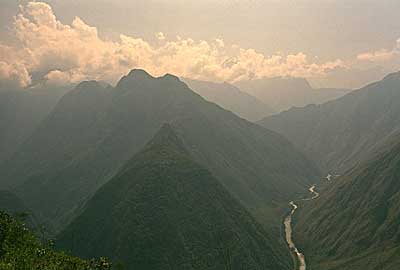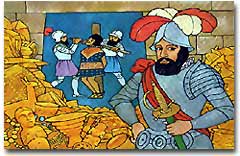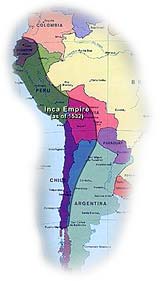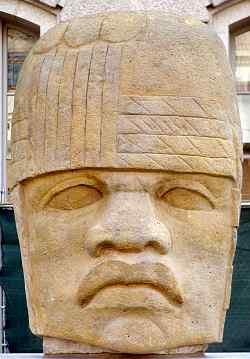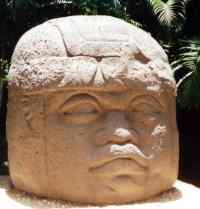The
Maya are an indigenous
people of Mexico and Central America who have continuously inhabited the
lands comprising modern-day Yucatan, Quintana Roo, Campeche, Tabasco,
and Chiapas in Mexico and southward through Guatemala, Belize, El
Salvador and Honduras. The designation
Maya comes from the ancient Yucatan
city
of Mayapan, the last capital of a Mayan Kingdom in the Post-Classic
Period. The Maya people refer to themselves by ethnicity and language
bonds such as
Quiche in the south or
Yucatec in the
north (though there are many others). The `Mysterious Maya’ have
intrigued the world since their `discovery’ in the 1840's by John Lloyd
Stephens and Frederick Catherwood but, in reality, much of the culture
is not that mysterious when understood. Contrary to popular imagination,
the Maya did not vanish and the descendants of the people who built the
great
cities of
Chichen Itza, Bonampak,
Uxmal
and Altun Ha still exist on the same lands their ancestors did and
continue to practice, sometimes in a modified form, the same rituals
which would be recognized by a native of the land one thousand years
ago.
MAYA Origins
The history of Mesoamerica is usually divided into specific periods
which, taken together, reveal the development of culture in the region
and, for the purposes of this definition, the emergence and cultivation
of the
Maya Civilization.
The
Archaic Period:
7000-2000 BCE – During this time a hunter-gatherer culture began to
cultivate crops such as maize, beans and other vegetables and the
domestication
of animals (most notably dogs and turkeys) and plants became widely
practiced. The first villages of the region were established during this
period which included sacred spots and temples dedicated to various
gods. The villages excavated thus far are dated from 2000-1500 BCE.
The
Olmec Period: 1500-200
BCE – This era is also known as the Pre-Classic or Formative Period
when the Olmecs, the oldest culture in Mesoamerica, thrived. The Olmecs
settled along the Gulf of Mexico and began building great cities of
stone and brick. The famous Olmec heads strongly suggest highly
sophisticated skill in sculpture and the first indications of Shamanic
religious practices date from this period. The enormous size and scope
of Olmec ruins gave birth to the idea that the land was once populated
by giants. Though no one knows where the Olmecs came from, nor what
happened to them, they lay the foundation for all the future
civilizations in Mesoamerica.

The Zapotec Period: 600 BCE-800 CE – In the region surrounding
modern-day Oaxaca, the cultural center now known as Monte Alban was
founded which became the capital of the Zapotec kingdom. The Zapotecs
were clearly influenced by (or, perhaps, related to) the Olmecs and,
through them, some of the most important cultural elements of the region
were disseminated such as
writing, mathematics, astronomy and the development of the calendar; all of which the Maya would refine.
The Teotihuacan Period: 200-900 CE – During this era the great city
of Teotihuacan grew from a small village to a metropolis of enormous
size and influence. Early on, Teotihuacan was a rival of another city
called Cuicuilco but, when that community was destroyed by a volcano c.
100 CE, Teotihuacan became dominant in the region. Archaeological
evidence suggests that Teotihuacan was an important religious center
which was devoted to the worship of a Great Mother Goddess and her
consort the Plumed Serpent. The Plumed Serpent god Kukulkan (also known
as Gucamatz) was the most popular deity among the Maya. Like many of
the cities which now lie in ruin throughout the southern Americas,
Teotihuacan was abandoned sometime around 900 CE.
The El Tajin Period: 250-900 CE – This period is also known as the Classic Period in Mesoamerican and Mayan history.
The El Tajin Period: 250-900 CE – This period is also known as the
Classic Period in Mesoamerican and Mayan history. The name `El Tajin’
refers to the great city complex on the Gulf of Mexico which has been
recognized as one of the most important sites in Mesoamerica. During
this time the great urban centers rose across the land and the Maya
numbered in the millions. The very important ball game which came to be
known as Poc-a-Toc was developed and more ball courts have been found in
and around the city of El Tajin than anywhere else in the region. Who,
precisely, the people were who inhabited El Tajin remains unknown as
there were over fifty different ethnic groups represented in the city
and dominance has been ascribed to both the Maya and the Totonac.
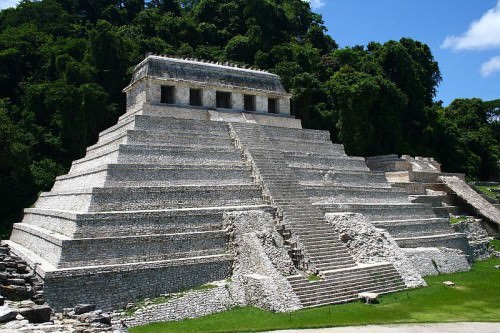
The Classic Maya Period: 250-950 CE – This is the era which saw the
consolidation of power in the great cities of the Yucatec Maya such as
Chichen Itza and Uxmal. Direct cultural influences may be seen, in some
sites, from the Olmecs and the Zapotecs and the cultural values of
Teotihuacan and El Tajin but, in others, a wholly new culture seems to
have emerged (such as at Chichen Itza where, though there is ample
evidence of cultural borrowing, there is a significantly different style
to the art and architecture). This period was the height of the Maya
civilization
in which they perfected mathematics, astronomy, architecture and the
visual arts and also refined and perfected the calendar. The oldest date
recorded in this era is on Stele 29 in the city of
Tikal (292 CE) and the latest is from an inscription on the Stele at the site of Tonina (909 CE). The city-states of the
Mayan civilization stretched from Piste in the north all the way down to modern-day Honduras.
The Post-Classic Period: 950-1524 CE – At this time the great cities
of the Maya were abandoned. Thus far, no explanation for the mass exodus
from the cities to outlying rural areas has been determined but climate
change and over population have been strongly suggested among other
possibilities. The Toltecs, a new tribe in the region, took over the
vacant urban centers and re-populated them. At this time, Tula and
Chichen-Itza became dominant cities in the region. The widely popular
conception that the Maya were driven from their cities by the Spanish
Conquest
is erroneous as the cities were already vacant by the time of the
Spanish invasion (in fact, the Spanish conquerors had no idea the
natives they found in the region were responsible for the enormous
complexes of the cities). The Quiche Maya were defeated at the
Battle of Utatlan in 1524 CE and this date traditionally marks the end of the Maya Civilization.
MAYA Culture
The height of the Maya Civilization in the Classic Period produced
the incredible cultural advances for which they are well known. The Maya
believed deeply in the cyclical nature of life – nothing was ever
`born’ and nothing ever `died’ – and this belief inspired their view of
the gods and the cosmos. Their cosmological views, in turn, encouraged
their imaginative efforts in architecture, mathematics, and astronomy.
Beneath the earth was the dark realm of Xibalba (pronounced
`shee-Bal-ba’ and translated as `place of fear’) from whence grew the
great Tree of Life which came up through the earth and towered into the
heavens, through thirteen levels, to reach the paradise of Tamoanchan
(`place of the misty sky’) where beautiful flowers bloomed. In Mayan
belief, however, one did not die and go to a `heaven’ or a `hell’ but,
rather, embarked on a journey toward Tamoanchan. This journey began in
the dark and treacherous underworld of Xibalba where the Xibalbans who
lived there were more apt to trick and destroy a soul than help one.
If one could navigate through Xibalba, however, one could then find
the way to ascend through the nine levels of the underworld, and the
thirteen levels of the higher world, to paradise. The only ways in which
a soul could by-pass Xibalba and travel instantly to Tamoanchan were
through death in childbirth, as a sacrificial victim, in
warfare,
on the ball court, or by suicide (the Maya had a special goddess of
suicide named Ixtab who was depicted as the rotting corpse of a woman
hanging by a noose in the heavens). Once one reached Tamoanchan there
was eternal happiness but, it must be noted, this paradise was not
thought to actually exist in the sky but on the earth. After ascending
through the thirteen levels, one did not live in the air but, rather, on
a mystical mountain back on the planet. It was because of this cyclical
view that the Maya did not believe there was anything wrong with human
sacrifice. Those people who were offered to the gods did not `die' but
simply moved on. This cosmological belief influenced every aspect of the
Mayan civilization and rituals were performed regularly in caves,
evoking the darkness of Xibalba, and on hills or high temples which
symbolized the heights of Tamoanchan.
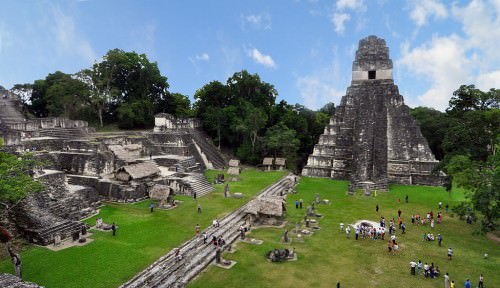
The great
pyramids
which characterize so many Mayan sites are replicas of the great
mountain of the gods known as the Witzob. The cyclical nature of human
existence is mirrored in the famous Maya calendar. The depictions of the
many gods and goddesses all go toward their function in helping one
through the cycles of life or hindering. The great religious book of the
Quiche Maya, the Popol-Vuh, tells precisely this story of the cyclical
nature of life through the tale of the Hero Twins Hunahpu and Xbalanque
and their victory over the forces of chaos and darkness symbolized by
the Lords of Xibalba. The game the twins are famous for playing,
Poc-a-Toc, serves the same purpose.
Poc-a-Toc was the most popular game among the Maya and was far more
than `just a game’ as it symbolized the human struggle and reflected the
way the Maya viewed existence. Two opposing teams of seven men each
would face each other on a ball court and try to score a small rubber
ball through a vertical hoop affixed to a
wall
(sometimes as high as twenty feet in the air, sometimes higher) while
defending their own goal. What makes the game even more impressive is
that a player could not use the hands or the feet, only the hips,
shoulders, head and knees. The Spanish bishop Diego de Landa wrote that
watching the Maya play Poc-a-Toc was like watching lightning strikes,
they moved so quickly. It has long been believed that the losing team
(or the captain of the losing team) would be killed at the end of the
match but recent advances in deciphering the Mayan glyphs, together with
archaeological evidence, suggests it may have been the winning team or
the winning captain who was given the honor of a quick death and instant
passage to paradise. The game is thought to have been symbolic, not
only of the victory of the hero twins over darkness, but of the cyclical
nature of life. The Mayanists Schele and Matthews claim, "Many modern
myths have grown up about the ballgame. The most popular says that the
Maya sacrificed the winners so as to give a perfect gift to the gods.
There is no evidence for this interpretation in any of the ancient or
historical sources" (210). This is not quite correct, however, as glyphs
at many ball courts, Chichen Itza to name only one, could be
interpreted as showing the winning team or captain being sacrificed and
modern Mayan daykeepers at both Altun Ha in Belize and Chichen Itza in
the Yucatan point to the hope of escape from the darkness of Xibalba as
the reason for the winners being executed. Whichever team was chosen to
die, and under what circumstances (since teams could not have been
continually sacrificed as there is evidence of `star' teams) the ball
game was deeply meaningful to the Maya as more than just a spectator
sport. More information on the particulars of the game, and the life of
the ancient Maya in general, comes to light as more heiroglyphics are
discovered and interpreted.
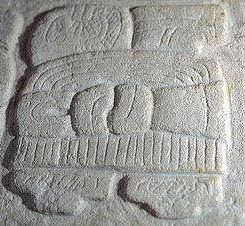
MAYAN Hieroglyphics
The modern day difficulty in deciphering the Mayan hieroglyphics
stems from the actions of the same man who, inadvertently, preserved so
much of what we know of the Maya Civilization: Bishop Diego de Landa.
Appointed to the Yucatan following the Spanish conquest of the north,
Landa arrived in 1549 CE and instantly set himself to the task of
routing out heathenism from among the Mayan converts to
Christianity.
The concept of a god who dies and comes back to life was very familiar
to the Maya from their own deity The Maize God and they seem to have
accepted the story of
Jesus Christ
and his resurrection easily. Even so, Landa believed that there was a
subversive faction growing among the Maya which was seducing them `back
to idolatry’ and, having failed to crush this perceived rebellion
through the avenues of prayer and admonition, chose another more direct
method.
On 12 July 1562 CE, at the church at Mani, Landa burned over forty
Mayan Codices (books) and over 20,000 images and stele. In his own
words, “We found many books with these letters, and because they
contained nothing that was free from superstition and the devil’s
trickery, we burnt them, which the Indians greatly lamented.” Landa went
further, however, and resorted to torture to extricate the secrets of
the subversives among the natives and bring them back to what he saw as
the true path of the church. His methods were condemned by the other
priests and he was called back to Spain to explain his actions. Part of
his defense was his 1566 CE work
Relacion de las Cosas de Yucatan
which has preserved much of the culture Landa tried to destroy and has
proved to be a valuable asset in understanding ancient Maya culture,
religion, and language.
Only three books of the Maya escaped the conflagration at Mani:
The Madrid Codex,
The Dresden Codex, and
The Paris Codex
(so named for the cities where they were found many years after they
were brought back from the Yucatan) which have provided scholars with a
great deal of information on the beliefs of the Maya and, especially, on
their calendar. The codices were created by scribes who made careful
observations in astronomy (the
Dresden Codex alone devotes six pages to accurately calculating the rising and positions of
Venus)
and their interpretations of the planets and the seasons exhibit a
precision unmatched by other ancient civilizations. So important were
their stories and books to the Maya that the
Legend of Zamna and the
Hennequen Plant describes the great goddess telling the prophet Zamna:
I want you to choose a group of families from my kingdom, and three
of the wisest Chilames, to carry the writings which tell the story of
our people, and write what will happen in the future. You will reach a
place that I will indicate to you and you will found a city. Under its
main temple you will guard the writings and the future writings.
The city of Izamal was founded, according to this legend, by Zamna
(associated with the deity Itzamna) of the Itzas who placed the sacred
writings under the central temple. Izamal became known as the most
important pilgrimage site in the Classical Period besides Chichen Itza.
Shamans (known as Daykeepers) would interpret the particular energy of
the day or month for the people by consulting with the gods presiding
over the various months of the Maya calendar.
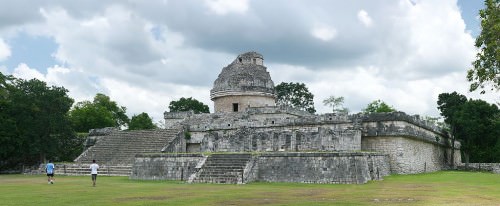
MAYA Calendar
There are two calendars at work simultaneously in the Maya system:
the Haab, or civil calendar of 365 days in an 18 month period of 20 days
each, and the Tzolkin, or sacred calendar, of 260 days divided into
three groups of months of 20 days. The Haab and the Tzolkin work
together, like gears interlocking in a machine, to create what is known
as the Calendar Round but cannot account for dates farther in the future
than 52 days. For longer calculations, the Maya devised what is known
as the Long Count Calendar and is this which has attracted so much
international attention in recent years regarding the end of the world
on 21 December 2012 CE. As the long count calendar begins 11 August 3114
BCE, it goes into its next cycle (known as a Baktun) on 21 December
2012 CE.
There is nothing in the extant writings of the Maya to suggest any
kind of cataclysm accompanies this transition. On 10 May 2012 CE it was
reported that Boston University archaeologist William Saturno and Boston
University student Maxwell Chamberlain, excavating at the Maya site of
Xultun in Guatemala, discovered a 6x6 foot room dating to 800 CE which
seems conclusively to have been a calendar workshop for Mayan scribes.
The paintings and inscriptions on the walls of the room show the Maya
calendar extending well beyond the year 2012 CE and that future Baktuns
were understood to already be underway in the great cyclic dance of
time. According to David Stuart, an expert on Maya hieroglyphs at the
University of Texas at Austin, "Baktun 14 was going to be coming, and
Baktun 15 and Baktun 16. ... The Maya calendar is going to keep going,
and keep going for billions, trillions, octillions of years into the
future."
The months of the years of the Mayan calendars were governed over
each by a specific god and, as these gods were eternal, they assured the
continuance of the energy of their particular month. As all of life was
considered one eternal cycle, the western concept of an `end of the
world’, so popular in Christian ideology, would have been a completely
foreign concept to a Maya scribe.
MAYA Today
In the modern age the Maya still farm the same lands and travel the
same rivers as their ancestors did from the north in the Yucatan down to
Honduras. The claim that the Maya somehow vanished, simply because
their cities were found abandoned, is not only inaccurate but insulting
to the over six million Maya who carry on the traditions of their
ancestors. Though the region was Christianized in the 16th century CE
conquest and inquisition, the old ways are still observed in a hybrid
between European Catholicism and Mayan mysticism. The Daykeeper of a
village still interprets the energy of a day and rituals are still
performed in caves and on hills. On the island of Cozumel shrines to the
Virgin Mary and the goddess Ixchel are interchangeable and, often, one
and the same. A great deal has been learned about the Maya since the
days when Stephens and Catherwood explored and documented the ancient
ruins but, for the Maya living today, nothing of importance has ever
been forgotten and the cycle of life continues on.
http://www.ancient.eu/Maya_Civilization/

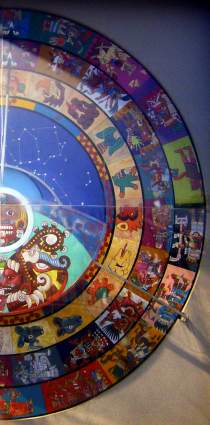
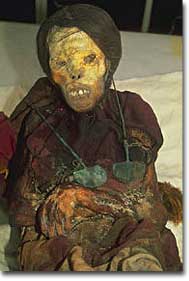 The Mountain Institute, West VirginiaThis
mummified girl was discovered in 1995 on Mount Ampato in the Andes
Mountains of Peru at an altitude of over 20,000 feet. She was sacrificed
by Inca priests nearly 500 years ago.
The Mountain Institute, West VirginiaThis
mummified girl was discovered in 1995 on Mount Ampato in the Andes
Mountains of Peru at an altitude of over 20,000 feet. She was sacrificed
by Inca priests nearly 500 years ago.